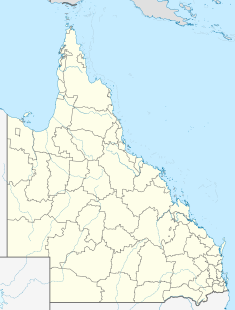Swansons Rail Bridge
| Swansons Rail Bridge | |
|---|---|

Swansons Rail Bridge, 2014
|
|
| Location | 6km north of Toowoomba, Ballard, Lockyer Valley Region, Queensland, Australia |
| Coordinates | 27°30′37″S 151°57′43″E / 27.5104°S 151.962°ECoordinates: 27°30′37″S 151°57′43″E / 27.5104°S 151.962°E |
| Design period | 1870s - 1890s (late 19th century) |
| Built | 1899 - 1900 |
| Architect | William Pagan (railway engineer) |
| Official name: Swansons Rail Bridge | |
| Type | state heritage (built) |
| Designated | 21 October 1992 |
| Reference no. | 600871 |
| Significant period | 1890s, 1900s (fabric) |
| Significant components | pier/s (bridge), abutments - railway bridge |
| Builders | day labour |
Swansons Rail Bridge is a heritage-listed railway bridge at 6 km north of Toowoomba at Ballard, Lockyer Valley Region, Queensland, Australia on the Main Line railway. It was designed by William Pagan and built from 1899 to 1900 by day labour. It was added to the Queensland Heritage Register on 21 October 1992.
Following separation from New South Wales in 1859, the first Queensland Parliament met in May 1860. It was almost precisely three years later, in May 1863, that the bill to authorise construction of the first railway was introduced. It was passed in September of that year and provided for the construction of a line by the government from Ipswich to Toowoomba, Dalby and Warwick - the Southern and Western Railway as it was first called.
Construction of Swanson's Bridge was commenced in 1899 and was completed in 1900. The new Swanson's Bridge replaced a former bridge of deck-type metal truss construction built in 1867 with the initial construction of the Main Range railway now known as the Main Line railway. As built, the Main Range railway had a considerable number of bridges which over the years were replaced by embankments and culverts so that the number of original bridges became fewer. But in 1899 an official three-year program was commenced to ease curves on the railway and replace high timber bridges with concrete culverts due to the increasing weight of rolling stock. The construction of Swanson's Bridge was a part of this program. The Commissioner's Annual Report for 1900 (p 76) notes:
Deviations on the Main Range for the purpose of easing curves and substituting earth embankments and concrete works for the iron bridges, which have been condemned as being too light for the increasing weight of rolling stock, have been carried on continuously by day labour. Several have been opened for traffic, including a three-concrete-arch viaduct.
...
Wikipedia


